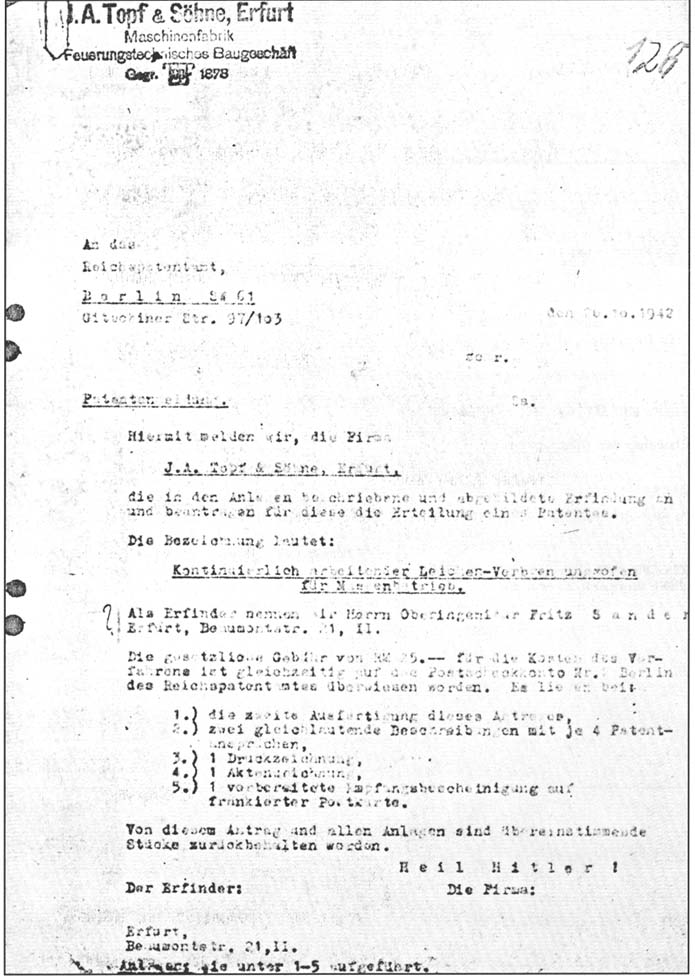
The end of 1942 was a prosperous period for the Topf crematorium construction division in all respects: new markets had opened up (in the concentration camps and the East) and new products had been designed and sold. Quite apart from Kurt Prüfer’s furnaces, the engineer Fritz SANDER filed a patent application on 26th October 1942 for his design for a CONTINUOUS cremation furnace [Documents 5 and 6], which was contrary to the law then in force in the Third Reich, but had been conceived to “absorb” the high mortality rate caused by events of the time (in the Soviet Union). This patent application seems to have been lodged in haste, for it was corrected and resubmitted on 4th November 1942. On 16th November, another patent application was made, this time for a method of air cooling furnace combustion grates in order to prolong their life [Document 7]. Although this patent application was found attached to that of Fritz Sander, the author of this improvement is not named. In addition, in order to meet Auschwitz Camp Commandant Hoess' desire to build on the experience already acquired by the SS with open-air cremation pits, Prüfer drew up a project for an “open” furnace, mentioned in a letter of 12th February 1943. This new “invention” was never actually implemented because Birkenau already had more than enough cremation capacity.
From January to June 1943, a Topf fitter, Messing, worked in Krematorien II and III, installing the furnace pulsed-air blowers, the forced draught system and the different ventilation systems (for the undressing rooms, gas chambers, furnace rooms, dissecting and annex rooms) and finally the corpse lifts. His timesheets, covering the work done each week, constitute damning evidence of the criminal conversion of these buildings. In the second week of March, the ventilation system of Leichenkeller I (the gas chamber) in Krematorium II, designed and built for the conditions of a morgue, was tested by Messing to see if it could satisfactorily evacuate an atmosphere poisoned by hydrocyanic acid gas. These tests were conclusive. As from 15th March 1943, the date of the first homicidal gassing in Krematorium II. Messing could not help but see the extermination of the Jews, directly or indirectly, until he finally left the camp on 8th June 1943. He was back in Erfurt on 11th June and it is inconceivable that he did not talk about what was happening in Birkenau, even to close friends. This would imply that by word of mouth all or part of the German staff of Topf must have known about the true utilization of the furnaces that were being manufactured.
Krematorium IV was completed on 22nd March, Kr II on 31st, Kr V on 4th April and Kr III on 25th June 1943. However, things went by no means as smoothly as Prufer had expected and the SS hoped. At the beginning of May 1943, Krematorien II and IV had to shut down, Kr II with a damaged chimney and Kr IV with damage to both furnaces and chimneys. It was possible to reline the Kr II chimney, but the damage to Kr IV was irreparable, since it was not so strongly built and inferior materials, the only ones available at the time, had been used, The problems with Kr IV showed that Kr V could not be much better as it was built identically, so it had to be used very carefully in order to try to extend its life. The Bauleitung were extremely annoyed about the shutdown of Krematorien IV (permanent) and V (partial), which meant they had wasted between 400,000 and 410,000 RM. Prüfer was implicitly held responsible, and as from summer 1943 relations between him and the Bauleitung became somewhat strained and began to turn sour.
[Beriebsarchiv VEB Erfurter Mälzerai, und Speicherbau. Erfurt]

Translation:
J. A. Topf & Sons, Erfurt
Engineering Works
Technical heating installation constructors
Established TOPF 1878
26/10/1942
To the
Reich Patent Office
Berlin SW 61
Gitschinerstraße 97/103
Author
Sander
Patent application
We, the firm
J. A. Topf & Sons, Erfurt
hereby notify the discovery described and presented in the enclosures and request the issue of a patent for it.
The description concerns:
Continuous operation corpse incineration furnace
for intensive use
As inventor, we designate the chief engineer Fritz Sander, Erfurt, Beaumontstraße 21, II.
The legally prescribed filing fee of 25 RM for the cost of the procedure is being sent at the same time to the Reich Patent Office Postal Cheque Account No. 2[?] in Berlin. Enclosed please find:
- The second copy of this Application;
- Two identical descriptions, each with 4 patent claims;
- 1 print of the drawing;
- 1 drawing for file:
- 1 one stamped and addressed acknowledgment of receipt card.
True copies of this Application and all enclosures have been retained.
Heil Hitler!
The inventor
The firm
Erfurt,
Beaumontstraße 21, II.
Enclosures: As listed in 1 to 5.
